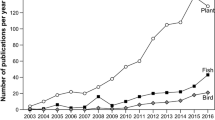Abstract
The amphipodGammarus pulex L. displayed aggregative behavior when stimulated by exudates from the isopodAsellus aquaticus L. in laboratory experiments, while the isopod avoided its predator by chemotaxis. Nonvolatile exudates from the amphipod significantly increased the respiration rate of the isopod. Exudation of free amino acids was greatly enhanced when both species were present in the same water, and it was calculated that the increased exudation by the prey was equivalent to a loss of 4–5% of its assimilated energy.
Similar content being viewed by others
References
Atema, J., andBurd, G.D. 1975. Afield study of chemotactic responses of the marine mud snail,Nassarius obsoletus.J. Chem. Ecol. 1:243–251.
Atema, J., andStenzler, D. 1977. Alarm substance of the marine mud snail,Nassarius obsoletus: Biological characterization and possible evolution.J. Chem. Ecol. 3:173–187.
Bengtsson, G., andOdham, G. 1979. A micromethod for the analysis of amino acids and its application to biological systems.Anal. Biochem. 92:426–443.
Bärlocher, F., andKendrick, B. 1973. Fungi and food preferences ofGammarus pseudolimnaeus.Arch. Hydrobiol. 72:501–506.
Bärlocher, F., andKendrick, B. 1974. Dynamics of the fungal population on leaves in a stream.J. Ecol. 62:761–791.
Cos, J.D., andPilcher, G. 1970. Thermochemistry of Organic and Organometallic Compounds. Academic Press, New York.
Dresel, E.I.B., andMoyle, V. 1950. Nitrogenous excretion of amphipods and isopods.J. Exp. Biol. 27:210–225.
Garnick, E. 1978. Behavioral ecology ofStrongylocentrotus droebackiensis (Muller) (Echinodermata: Echinoidea). Aggregating behavior and chemotaxis.Oecologia (Berlin) 37:77–84.
Kostalos, M., andSeymour, R.L. 1976. Role of microbial enriched detritus in the nutrition ofGammarus minus (Amphipoda).Oikos 27:512–516.
Krebs, J.R., andDavies, N.B. 1978. Behavioral Ecology, An Evolutionary Approach. Blackwell Scientific Publ, London.
Macarthur, R.H., andPianka, E.R. 1966. On the optimal use of a patchy environment.Am. Nat. 100:603–609.
Meister, A. 1972. Biochemistry of the Amino Acids, Vol. I. Academic Press, New York.
Nenninger, U. 1948. Die Peritrichen der Umgebung von Erlangen mit besonderer Berūcksichtigung ihrer Wirtsspezifität.Zool. Jahrb. Abt. Syst. 77:169–266.
Nilsson, L.M. 1974. Energy budget of a laboratory population ofGammarus pulex L. (Amphipoda).Oikos 25:35–42.
Pfeiffer, W., andLemke, J. 1973. Untersuchungen zur Isolierung und Identifizierung des Schreckstoffes aus der Haut der Elritze,Phoxinus phoxinus (L.).J. Comp. Physiol. 82:407–410.
Phillips, D.W. 1977. Avoidance and escape responses of the gastropod molluscOlivella biplicata (Sowerby) to predatory asteroids.J. Exp. Mar. Biol. Ecol. 28:77–86.
Phillips, D.W. 1978. Chemical mediation of invertebrate defensive behaviors and the ability to distinguish between foraging and inactive predators.Mar. Biol. 49:237–243.
Prus, T. 1971. The assimilation efficiency ofAsellus aquaticus L. (Crustacea, Isopoda).Freshwater Biol. 1:287–305.
Rossi, L., andFano, E.A. 1979. Role of fungi in the trophic niche of two congeneric detrivorous species:Asellus aquaticus L. andAsellus coxalis Dollf.Oikos 32:380–385.
Stephens, G.C. 1972. Amino acid accumulation and assimilation in marine organisms, pp. 155–184,in J.W. Campbell and L. Goldstein (eds.). Nitrogen Metabolism and the Environment, 1st ed. Academic Press, New York.
Stiles, F.G., andWolf, L.L. 1970. Hummingbird territoriality at a tropical flowering tree.Auk 87:467–491.
Woodbridge, R.G., III. 1978. The common periwinkle,Littorina littorea, Linne, attracted by sugars.Experentia 34:1445.
Author information
Authors and Affiliations
Rights and permissions
About this article
Cite this article
Bengtsson, G. Energetic costs of amino acids exudation in the interaction between the predatorGammarus pulex L. and the preyAsellus aquations L.. J Chem Ecol 8, 1271–1281 (1982). https://doi.org/10.1007/BF00987760
Received:
Revised:
Issue Date:
DOI: https://doi.org/10.1007/BF00987760




